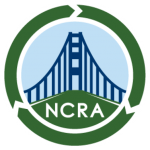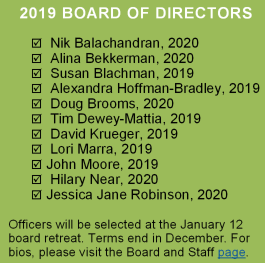The National Recycling Coalition 2018 Awards Recipients, 10/15/18
Yesterday, The National Recycling Coalition (NRC) honored their recycling awards recipients at the 2018 Resource Recycling Conference in St. Louis. The awards were presented to the winners, along with the recipients of the Murray J. Fox Scholarship, at a special ceremony. The awards were especially meaningful on the 40th anniversary of the founding of NRC.
The awards program is designed to honor and recognize outstanding individuals, programs, and organizations around the country, both for their achievements, and to serve as a model and a resource for learning for NRC members. Award categories recognize outstanding programs in for-profit businesses, higher education, non-profit organizations, and community / governmental programs, as well as awards for outstanding emerging leader and lifetime achievement. The NRC will be posting information on all winners on the NRC’s website.
NRC’s Awards Committee Chair Lisa Skumatz commented on the process saying of fellow committee members, “They worked long and hard to sort from among the huge number of submittals to find those shining examples – a task that was made particularly hard because there were so many really stellar nominees.” She noted that “The winners embodied best practices, and we were very pleased that winners came from across the country to accept their awards, so attendees had the chance to learn first-hand how these programs work so well!”
Jack DeBell, Chair of the Murray J. Fox Scholarship program presented three St. Louis-area university students with scholarships to assist in their education.
2018 Awards
- Lifetime Achievement in Recycling – Gary Liss
- Bill Heenan Emerging Leader – Leana Houser, Johns Hopkins University
- Outstanding Community / Government Program – County of Santa Cruz
- Outstanding Business Leadership-For Profit Company – Cox Enterprises , Atlanta
- Outstanding Not-for-Profit Business Leadership -Bridging the Gap, Kansas City, MO
- Outstanding Recycling Organization – Colorado Association for Recycling (CAFR) / Recycle Colorado
- Outstanding Higher Education Winner – University of Wisconsin-Stevens Point
On hand to help present the awards were NRC’s Chair, Lisa Skumatz (of Skumatz Economic Research Associates); NRC’s President David Keeling (of the Steel Recycling Institute); and Marjorie Griek, NRC’s Executive Director.
Details of the Awards and Winners
Outstanding Business Leadership For-Profit Company: Cox Enterprises
Cox Enterprises believes working towards positive environmental change is important — both inside the company and in the communities they serve. This underlying principle influences their business operations and investments, acting as the catalyst for establishing their environmental sustainability division, Cox Conserves, in 2007. In 2013, Cox Conserves adopted three aggressive goals: carbon and water neutrality by 2044, and zero waste to landfill (ZWTL) by 2024 (diverting 90% of waste from landfill and incineration).
Cox has intensively focused on achieving ZWTL and developed purposeful programs aimed at properly managing their waste streams. Five years later, this call to action for ZWTL goes out to their companies across the US and entreats their employees to embrace environmental stewardship, enabling them to lead by example in this journey towards sustainability. These challenging goals demonstrate the organization’s commitment to being thoughtful stewards of the environment, while searching for innovative ways to grow the business responsibly.
Outstanding Not-for-profit Business Leadership: Bridging the Gap
Bridging The Gap (BTG) is a Kansas City based not-for-profit dedicated to environmental education and action through volunteer engagement. Bridging The Gap was founded in 1992 by attorney Robert J. Mann whose vision of community building across government, business and the private sectors soon translated into environmental activism.
BTG established the city’s first drop-off recycling center, helped establish many regional recycling centers, advocated for curbside recycling in KCMO, and eventually coordinated community education for the long-awaited curbside program when it was finally adopted, thirteen years later. Today, BTG is the home of many diverse environmental programs, including the Business Recycling Program which has helped over 130 businesses achieve waste reduction and implement recycling programs over the past five years.
Outstanding Recycling Organization: Colorado Association for Recycling / Recycle Colorado
Over the last few years, CAFR faced many of the same challenges other ROs were facing: mergers that reduced membership, programs suffering from lower market prices, contamination, and market challenges; and the complexities associated with very low landfill prices, a significant rural component, and weak state-level authorities. Rather than suffer a slow decline, CAFR shook things up, hiring a new ED, updating its vision / mission / operations plan, and adopting a mantra of undertaking only activities that were tangible, actionable, and measurable, and focusing on infrastructure, end markets, and policy. Member services were no longer the focus. They shook up the traditional model in membership, conference session design, councils, partnered with non-industry NGOs, solicited sponsors for targeted projects, and in one year increased membership 50%, and significantly exceeded sponsorship and revenue goals. To signal the change, they changed their name. This RO has ideas that can be learned from!
Outstanding Higher Education: University of Wisconsin – Stevens Point
The University of Wisconsin – Stevens Point has been running an exemplary recycling program since it was designated as a Solid Waste Experiment Center in 1990. Annually, over 500 tons of landfill waste is avoided and $17,000 saved on average in avoided landfill tipping fees.
The university’s Waste Education Center (WEC) is an extraordinary facility that functions as a materials recycling and composting facility, provides training in sustainable waste management practices and is used for research trials. WEC is administered by the College of Natural Resources (CNR). The CNR offers an undergraduate degree in Soil and Waste Resources with a Waste Management option to prepare students for jobs at landfills, wastewater treatment facilities, hazardous waste sites, recycling and composting centers. Students utilize the WEC as a classroom and lab, and perform research activities as well. Waste management graduates enjoy placement rates of 90-100% and work at private companies and government agencies.
Outstanding Community or Government Program: Santa Cruz County CA
Santa Cruz County has been a leader in recycling and waste reduction for decades. The source of many innovative programs from bans on plastic bags and Styrofoam to EPR programs for drugs and sharps, requirements for sustainable practices in food service businesses, composting of food waste, creative source reduction efforts, outstanding outreach and education programs and more, Santa Cruz County has won numerous awards and accolades from industry organizations, environmental groups and elected officials. They continue to model best practices for other programs around the country and to constantly strive toward greater sustainability and zero waste.
Bill Heenan Emerging Leader: Leana Houser
Leana Houser has dedicated herself to initiating and improving programs that ensure environmental and social responsibility are embedded in JHU operations, and shows the same commitment in her personal life – oftentimes bridging the two to blur lines and amplify impact. She helped found the regional network B’CaUSE (Baltimore Colleges and Universities for a Sustainable Environment), has served on the board for Friends of Patterson Park, and as been a mentor to numerous interns and employees at Hopkins.
Her charisma, creativity and compassion make her a valued leader adeptly able to bring different partners and stakeholders together to find common ground for the greater good. From connecting her daily work to divert furniture and provide waste bin infrastructure – the diversion of which improves public health across the city by avoiding the incinerator – to connecting the work of those city nonprofits by way of furniture and bin donations, Leana leads by example.
Lifetime Achievement in Recycling – Gary Liss
Mr. Gary Liss has over 40 years of experience in the solid waste and recycling field. He was a founder and past President of the National Recycling Coalition and was Solid Waste Manager for the City of San Jose, CA. In San Jose, Mr. Liss developed their recycling programs into national models, which are currently diverting 62% of the overall waste stream. In addition, Mr. Liss is a leading advocate of Zero Waste, and a special Zero Waste advisor to the GrassRoots Recycling Network (GRRN). Gary Liss’s litany of achievements started in 1970 helping start students organized against pollution (SOAP) at Tufts, continued through MassPirg, appointments with Sierra Club of New Jersey, Engineering Department in Newark, NJ, NJ State Department of Energy working on Alternate Technologies to focus on Recycling, and closed out the 1970s by writing part of NJ’s energy master plan setting a statewide goal of 25% recycling, worked with the Institute for Self Reliance, US Conference of Mayors, and serving as the Sierra Club representative to join the first Board of the NRC / and was elected chair in 1978. And those are just his efforts in the 1970s.
In the 1980s, he moved to California and started moving things forward there. He worked on waste issues in San Jose, continued on the Board of the NRC, and worked on waste reduction strategies at the municipal level.
In the 1990s, and specifically in 1995, he helped develop the Grass Roots Recycling network to champion Zero Waste, started Gary Liss & Associates, and began the work he continues to this day – working with the NRC, and helping communities across North America and internationally on Zero Waste. His current titles include: President Gary Liss & Associates, a Founding Board Member and Past President of NRC; VP of Zero Waste USA; Board member Zero Waste International Alliance, and Past President US Zero Waste Business Council.
Gary is tireless, dogged, determined, and committed – and now his is also an award winner.
The National Recycling Coalition congratulates all of this year’s winners!
Notable sponsors and contributors of these awards include: SCS Engineers, Institute of Scrap Recycling Industries, Robert Gedert, Container Recycling Institute, Waste Management, Skumatz Economic Research Associates / SERA, George Dreckmann, Barbara Eckstrom, Fran McPoland, Susie Gordon, Melisssa Young, MaryEllen Etienne, Marjie Griek, NRC Executive Director, Mark Lichtenstein, NRC Board, Leslie Lukacs, Steel Recycling Institute, The Recycling Partnership, Dylan DeThomas.



